| The
Seven Liter Projects (Nov 2003) Back to Lou's Homepage 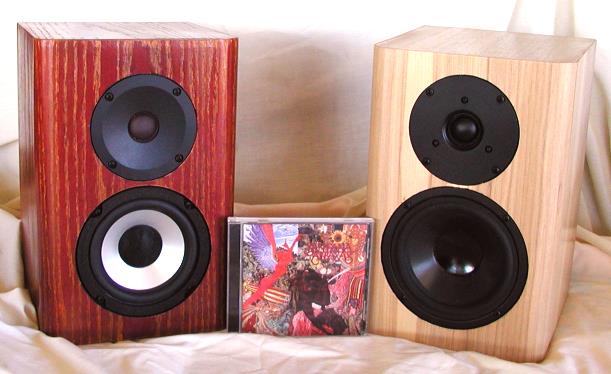 |
||||||||||||||||||
With Christmas coming, and DIY 2003 in Tucson, I decided to build some new small speakers to replace the Onyx. I looked for drivers that would work well in approximately 7 liters, (440 cu in). This seems like a manageable size for small living rooms (one requirement) and/or for home theater. Building all of the boxes at the same time certainly streamlines the construction and finishing process. It also gave me a chance to compare designs and test my voicing skills for consistency. I also got an opportunity to use my new Behringer ECM3000 microphone and UBB802 mixing console. I demo'd these at the Tucson DIY 2003. For the most part, people were impressed with both designs. Some folks were kind enough to offer refinements (like padding down the Garnet a bit). I've addressed those in the designs posted here.
|
||||||||||||||||||
|
|
||||||||||||||||||
When my brother asked for a compact monitor for his home in NoCal, I thought I'd use the last blank boxes from my 7 Liter projects. I liked the high end from the Sparky and the bottom end from the Garnet. I always felt the Vifa D27 had a bit too much sizzle for my taste. I had the woofers on hand, as well as second pair of 812978 tweeters. (I may be alone, but I like Peerless tweeters). So the Garnet II combo was born. |
||||||||||||||||||
|
The woofer still has a notch filter to tame the rising response of 108. However, I reduced the coil to 1.2 mH for less baffle step. The tweeter section adds a bypass cap to control diffraction and impedance effects of the tweeter. The net effect is a 2100 hz crossover frequency that is relatively insensitive to tweeter polarity. Padding is now in the 1-2 ohm range and this design appears 1-2 db more efficient than the original Garnet. |
|||||||||||||||||
| I borrowed back the original Garnet pair for comparison. The G2 benefits more from being closer to the wall. Overall, I prefer the G2 for it's mids and smoother upper bass. The orginal Garnet has a bit more sizzle at the top end, but I find the G2 smoother and less fatiguing. The G2 seems to run out of gas at the extreme high end. Overall, I find the G2 smoother and better balanced across the band. The Garnet seems a bit punchier, but won't handle higher power levels as gracefully as the G2. The finish is my first pass at dark "misson" oak. I made up a water based dye with Dark Mission Brown & Reddish Brown Transtint. This was sealed with two spray coats of dewaxed shellac. Next, I mixed black/burnt umber latex glaze to fill the pores. (You need to work quick!) Finally three coats of Fuhr 355 waterbased acrylic (gloss). As always, the second one looks better than the first. Either of
these designs would do well as a standalone monitor for music. Probably
not enough bottom end for hip-hop, techno types, but entirely adequate
for the over 30 crowd. |
||||||||||||||||||
|
The Sparky - High Quality Shielded Monitor for about $60
|
||||||||||||||||||
One of my friends is blessed with a hypertalented daughter who plays in three bands and orchestras. His son is interested in movie and sound editing. As a family project, they are recording the daughters performances and rendering them to DVD. They needed a set of shielded monitors for mastering. Since my friend and his wife graduated from Tempe Normal College (now known as Arizona State), I decided to finish the Sparkies in maroon & gold. (As a graduate of The University of Arizona, this was aesthetically difficult, -- but friendship won out) Looking in my driver stash, I found two MCM 55-1855 5" Aluminum cone shielded woofers. I checked around for folks who measured them. They looked nice out to about 2400 where they drop like a rock. I needed a good shielded tweeter with low Fs. After searching a bit I wound up with a Peerless 812978. Under $20 with Fs of about 940.
|
||||||||||||||||||
| This is a sweet little monitor with good solid bass down to about 60 hZ. Nice and smooth, great vocals, piano. I really like the Peerless tweeter. No sign of "grit". Not as airy as some but not as raspy either. The slight horn loading gives it a very precise placement. Details are there when they should be, but quiet otherwise. As much as I like the Audax TMO25, I think this Peerless is at least as good. Not as airy, but the extra range and power handling is a real plus. It is a step up from the little square Peerlesss neo. The MCM is better than expected especially for $14! Solid throughout it's range, a bit laid back, solid but not overwhelming bass. Definitely more bottom end than my sealed Topaz in a smaller box. These could easily serve as music mains in a reasonable room. The finish was my first experiment with filled pores. I veneered the box in red oak. After sanding with 180 and blowing everything clean, I prepared a water/alchohol base for dying. Using Transtint dye concentrates, I mixed up something I thought would look good. I used my cheapie detail gun to spray the dye. After drying for a day, I scuffed the surface and shot the boxes with two coats of 2# cut, pale dewaxed shellac. The glaze is a latex tinted with Transfast pigments. I brushed it on and tried to work it into the pores. I then wiped it off cross grain. It took a couple tries to get the right look. I also noted that any place where I got lazy sanding, or sealing, wound up as a different color. When the glaze was dry, I shot a coat of shellac to seal everything. Finally three coats of Fuhr 355 gloss, acrylic, waterbourne lacquer.
|
||||||||||||||||||
Garnet
Monitor - Serious Thump from a Small Box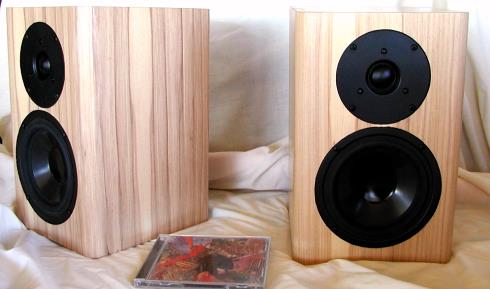 |
||||||||||||||||||
| The Garnet was intended for a "prosumer" friend of mine who retired and moved into a smaller place. She decided that her old JBL towers were just too overwhelming (and big) for her new townhouse. The Garnets are supposed to live on the mantle over the fire place. (We'll see!). She really liked my sealed Topaz monitors, but wanted something smaller with a bit more thump. | ||||||||||||||||||
After measuring and trying several "conventional" crossover topologies, I couldn't seem to tame the very gradual rising response of the Peerless in the 2500-3500 range. I thought the original imaging was too forward. So I wound up with the notch filter shown above to slightly reduce response in that range. Again the tweeter needed drastic padding down, but the impedance profile is more benign than the Sparky. Crossover is about 2100, 2nd order -- definitely pushing the bottom end of the Vifa. It models quite nice and has huge reverse null. The key tweaking point is the 3.3 ohm resistor. This moves the filter peak. The padding resistor could go to 25 if you like it a bit more laid back. According to LspCad, 3 ohms changes tweeter response by about 1 dB. Based on reactions at DIY, the bass from these is really impressive, (model suggests F3 of around 50). Most found the sound well balanced with a subdued mid and clear airy highs. Personally, I prefer the more precise Peerless sound to the air of the Vifa's. Most at DIY 2003 gave a slight nod to the Vifa. The bass is definitely "there" on the Garnet. Moved against a wall, it may be too heavy (for my taste). I estimate the sensitivity to be in the 85-86 range -- as opposed to the 82-83 for the Sparky. The Garnet won't handle huge volume levels (it's only a 5" woofer!) but in reasonably sized room it produces a very full soundstage, with nice depth detail and placement. You won't need a sub for reasonable levels. Pushed too hard, the Vifa gets gritty and the Peerless just works too hard. The finish is quarter cut Pecan, with three coats of Fuhr 355 gloss. I rubbed it out with 600, 1200, and 2000 to achieve the satin look.
|
||||||||||||||||||
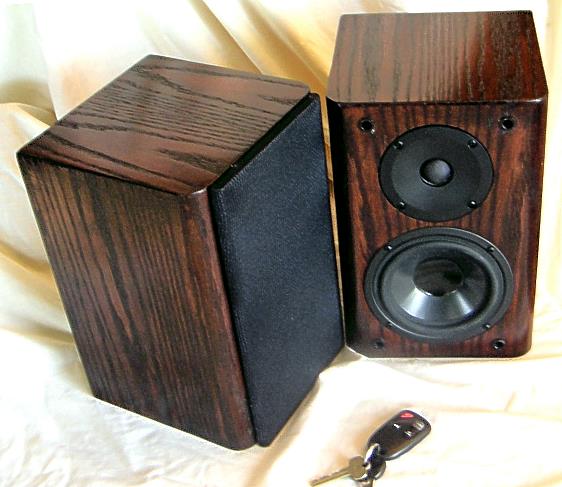
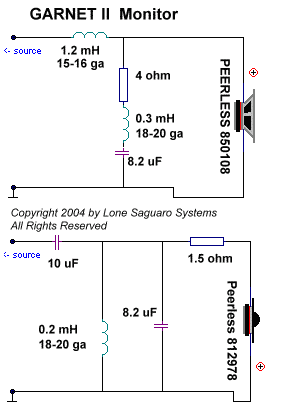
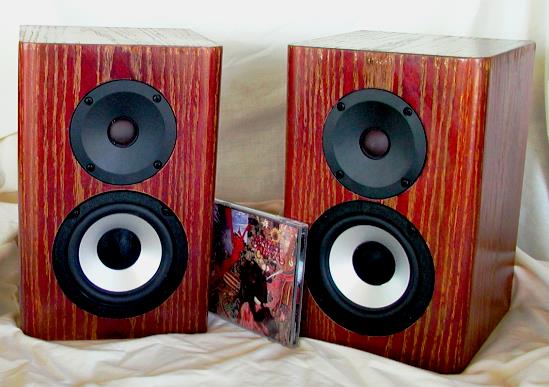
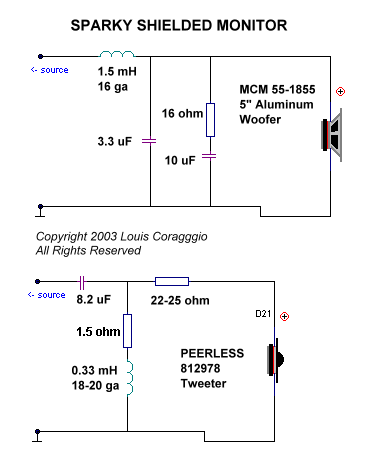 I
measured both drivers in the box as is my custom, and got them prepped
in LspCad. I was prepared to use notch filters to tame out resonance at
8000 Hz. With some wild impedance curves, a Zoebel was needed for the
MCM. After tweaking, I tried pulling the notch filter. With the slopes
used, it did not prove necessary. The 25 ohm padding resistor may look
a bit strange, but it's genuine. So is the 1.5 ohm resistor in series
with the tweeter shunt coil. The increased DCR is needed to keep the impedance
of this speaker reasonably level and to tame a slight diffraction peak.
Final crossover frequency is about 2200.
I
measured both drivers in the box as is my custom, and got them prepped
in LspCad. I was prepared to use notch filters to tame out resonance at
8000 Hz. With some wild impedance curves, a Zoebel was needed for the
MCM. After tweaking, I tried pulling the notch filter. With the slopes
used, it did not prove necessary. The 25 ohm padding resistor may look
a bit strange, but it's genuine. So is the 1.5 ohm resistor in series
with the tweeter shunt coil. The increased DCR is needed to keep the impedance
of this speaker reasonably level and to tame a slight diffraction peak.
Final crossover frequency is about 2200.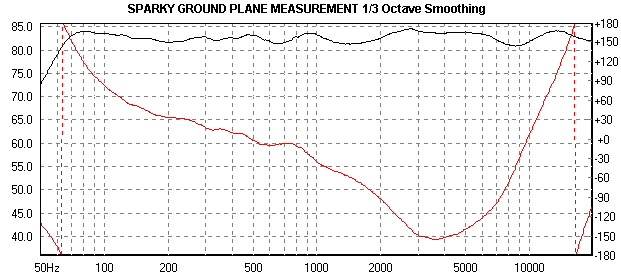
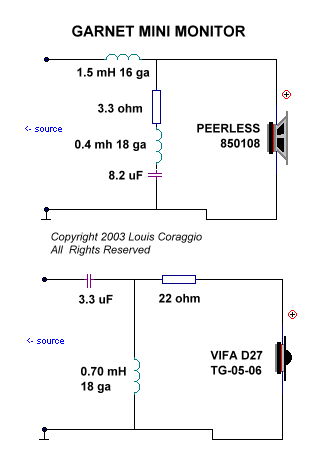 I'm
becoming somewhat a fan of Peerless drivers. I really haven't found one
I didn't like. (The aluminum ring dome tweeter is a bit gritty though.)
For this build, I selected the Peerless 850108 5.5" CSX. It modeled
nicely in the 7 liter box, is reasonably priced, and seems to be well
regarded by those who've used it. Since one of my goals is to reduce my
stash, I selected a pair of Vifa D27 TG-05-06. My first kit speakers (ACI
Emeralds) use these. I figured the Peerless would be good for 3000 if
needed.
I'm
becoming somewhat a fan of Peerless drivers. I really haven't found one
I didn't like. (The aluminum ring dome tweeter is a bit gritty though.)
For this build, I selected the Peerless 850108 5.5" CSX. It modeled
nicely in the 7 liter box, is reasonably priced, and seems to be well
regarded by those who've used it. Since one of my goals is to reduce my
stash, I selected a pair of Vifa D27 TG-05-06. My first kit speakers (ACI
Emeralds) use these. I figured the Peerless would be good for 3000 if
needed.